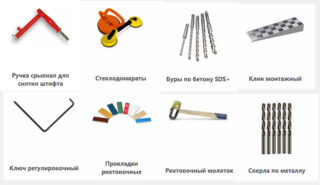To fix the block in the opening, fasteners are used that depend on the material of the walls: there is a variety for brick, wood, multilayer construction. The resistance of the frame to wind, shock, temperature jumps depends on the correct choice of fixing elements.
- Requirements for fasteners of plastic windows
- Types of fasteners
- Anchor or frame dowel
- Anchor plate
- Wood screws
- Concrete screws
- Required tools and materials
- The choice of fasteners for plastic windows for different types of buildings
- In a wooden or frame house
- Into concrete
- To the brick wall
- To aerated concrete
- To metal structures
Requirements for fasteners of plastic windows
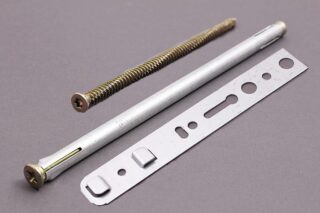
Plates, metal anchors, plastic dowels and self-tapping screws must ensure that the filling is rigidly fixed in the opening. As a result, the structure resists the wind (especially on the last floors), withstands wind conditions with an open transom.
In case of heat or frost, the dimensions of the frame change, the fasteners must allow the structure to move relative to the wall. In this case, the linear expansion is 1.5 mm per meter of the window. The frame elements are under the double action of internal heat and external cold, therefore stressful areas arise.
Types of fasteners
The GOST states that polyurethane foam cannot be used as a fastener for plastic windows, it is used only to seal the gap between the box and the end.
They use different types of fasteners:
- anchor plates;
- short, long dowels or anchors;
- self-tapping screws or wood screws;
- self-tapping screws for drilling into concrete.
The clamps must exclude the danger of the frame falling out of the opening.
Anchor or frame dowel
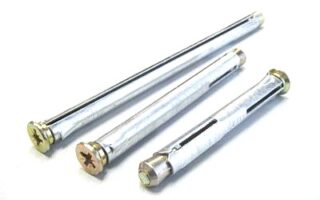
The structure consists of a sleeve, a screw, a sleeve with a surface galvanized layer. The principle of operation is that the screw and the upper section of the sleeve are located inside the collet, which increases in size as the screw rotates. This fixes the fastener in the hole.
Anchors are produced in two types:
- typical;
- for mounting in hollow supports.
The usual retainer is placed in brick, concrete.
Anchors for g / cardboard and other loose materials are distinguished by the structure of the sleeve, which does not expand, but deforms due to the longitudinal slots. The end opens to the sides and supports the anchor on the back of the thin-walled railing.
Anchor plate

Manufacturers of window profiles produce flat fasteners for PVC windows. The strips are attached to the frame by means of teeth and depressions or snap into the profile body. Such elements are interchangeable and multifunctional, so they can be used for other systems.
The strips are fixed with one end to the outer side of the frame, the other end is placed on the wall. With the plates, the window can be fixed quickly, conveniently and securely. The edges of the plates are visually distinguishable on the plane of the slope; decorative trim is needed to hide them.
Wood screws
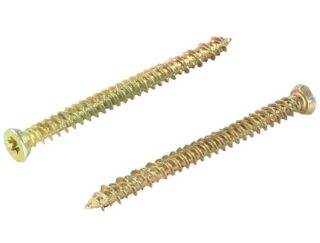
Self-tapping screws fix well in the walls of wooden buildings. When using a plastic dowel, such hardware can be installed in brick and concrete. A rod with a special thread, a tapered end, when screwed, cuts a thread in the body of the material and is firmly held there.
A hole is drilled under the screw screw, the diameter of which is 70-75% of the size of the hardware to the depth along the length of the fastener. Such screws can be easily unscrewed from the hole, but the number of dismantling cannot exceed 3-4 times, after which the fixation weakens.
Concrete screws
They are an alternative to anchors.The hardware is thicker than wood screws and provides a stronger fit. A hole is drilled in the concrete, then the self-tapping screw is tightened without installing a dowel. Due to significant loads, such hardware is often destroyed.
Screws for concrete are drilled through the frame, therefore, such window fasteners involve the removal of transoms and glazing elements, after installation, parts of the window block are installed in place.
Required tools and materials
Tools for dismantling old fillings and installing new ones:
- electric jigsaw, impact drill or hammer drill, screwdriver;
- chisel, crowbar, hammer, knife;
- drills for a hammer drill with a pobedit, a spatula nozzle, drills for metal;
- foam gun, iron scissors;
- plumb line, level, tape measure, square.
The window is mounted on a substitute profile, the slots are sealed with silicone sealant.
The choice of fasteners for plastic windows for different types of buildings
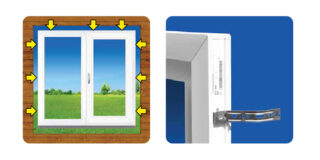
The type of retainer is determined by the material of the walls. Problems often arise in buildings with multi-layered vertical barriers or in walls made of loose and porous stones. There is air between the outer and inner layers, so the anchors fall into the void. In this case, install a mounting plate for PVC windows.
Previously, fasteners were installed for centuries, there were no problems with unscrewing, removing screws or anchors. In modern construction, people have begun to change window fillings more often, so they choose fasteners that can be easily dismantled if necessary.
In a wooden or frame house
If the block is attached directly to the end of the log house, it is better to install it on plates. The elements will give the necessary freedom when the wood shrinks. Block or frame houses change geometry throughout the year, but deformations can continue for a longer time.
In wooden buildings, a special casing is used - an additional box connected to the walls in a certain way. If such a design is provided, the frame is fixed through and through with self-tapping screws for wood.
Into concrete
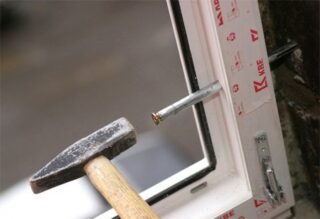
Anchors are used as fasteners for windows. Use the installation method with the removal of the structural parts of the window block. The frame freed from the double-glazed windows is burst with wedges, crossbars to fix it in the mounting position. Holes are drilled through the frame in the upper lintel, the walls, then anchor sleeves are inserted there, screws are placed in them, screwed in or hammered in until they stop.
Anchor plates can also be used. Universal elements are used for the installation of fillings in fences made of any material.
To the brick wall
If the masonry is made of high-quality bricks, the frames are fixed quickly and efficiently with the help of anchors. The problem arises if the ends of the openings have multiple chips, or poor quality brick was used for the construction of the building. Drilling under the anchor is difficult if the drill hits the seam of the masonry.
It is correct to use plates. In this case, you need to clearly see the drilling area and fix the end of the strip in the middle of the brick. If the drill hits the masonry seam, the plate can always be rearranged without disturbing the integrity of the frame.
To aerated concrete
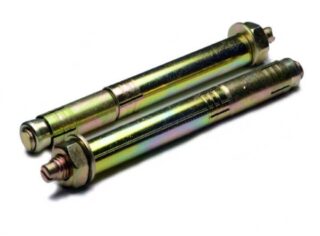
Aerated concrete and foam concrete are produced in different densities, the strength of the material depends on this indicator. For fixation, anchors with a length of up to 15 - 20 cm with a diameter of 10 mm are used. The window frame is drilled through and aerated concrete is drilled through this hole.
If the sleeve falls into the hollow hole of the aerated concrete block, it is better to take an anchor with a shank for porous and thin-walled structures. Then the end will open after the end of the dense wall and fix the anchor in the material.
To metal structures
The choice of fasteners is determined by the thickness of the metal structure to which the window will be installed.The frame is attached to the popular square tube with a wall of 2 mm with press washers without pre-drilling a hole. There is a metal through which a self-tapping screw fits perfectly.
If the metal is thick and the end of the threaded hardware is not enough to pass through the thickness of the iron, a mounting hole is first made, 0.5 mm narrower than the diameter of the self-tapping screw. Hardware with galvanized corrosion protection is used.

